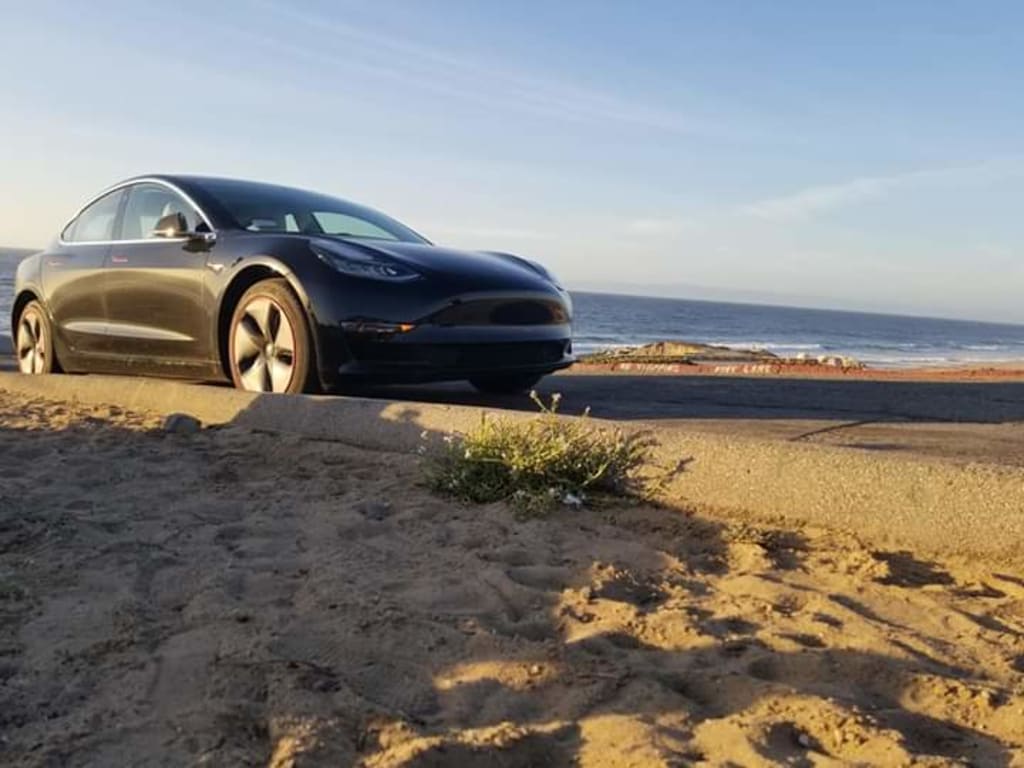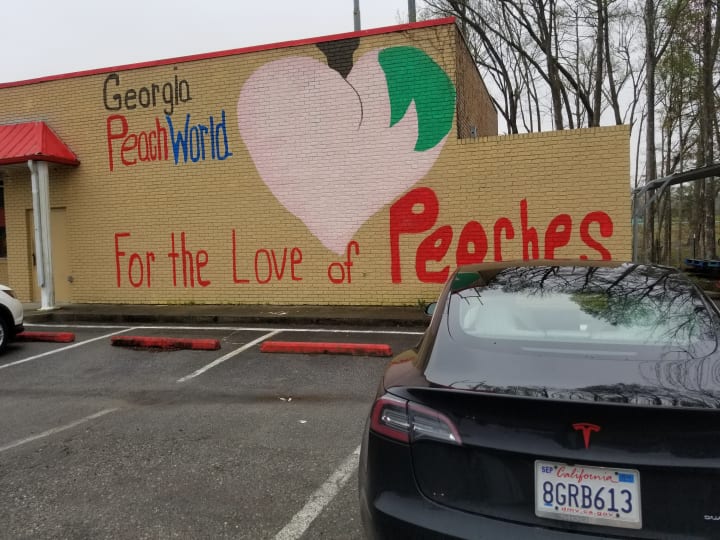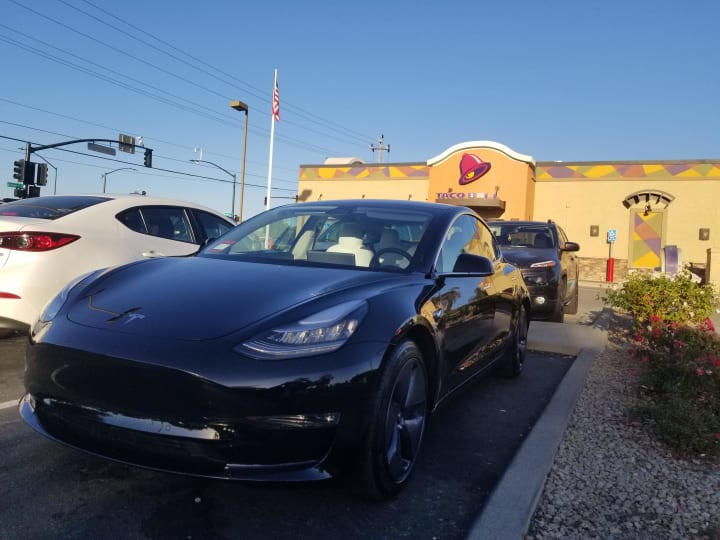Model 3 for Rideshare
An experience of using a Model 3 for rideshare.

Like most rideshare drivers, I don't use rideshare as my primary source of income (other than a brief stint between jobs), but rather as a supplement. It gets me out of the house, earns a (very little) bit of money, introduces me to new people, and helps me explore my city and larger area.
However,after getting my Tesla, one important thing has changed. Although all of those reasons are true, the number one most important reason behind doing rideshare is, simply, because I love to drive my car. If I am being honest, I now use rideshare as an excuse just to get out and drive my car more than anything else.
I could write an entire article on why a Telsa Model 3 was the right choice for me (and why it should be for most people), and perhaps I will, but this is about, specifically, using the Tesla for rideshare purposes. This article will be about not rideshare driving, and not about the Tesla Model 3, but specifically rideshare driving with a Tesla Model 3.
In my experience, the differences are best summed up in three main categories: the questions I have to answer, how using a Tesla is more convenient, and the profit I make. I will go into detail about exactly how these three affect rideshare driving in a Model 3.
This will get a bit long, and fair warning there's math regarding profits. Feel free to skip to the end, where I've provided a summary.
Questions

Driving across the country is just as enjoyable as driving across town.
Driving people you'll get loads of questions. This is above and beyond anything I've ever experienced in any of my conventional vehicles. People always ask about driving for rideshare. In the Model 3, they don't. They ask about Tesla instead.
The very first and the very last questions will nearly always be "How do I open the door?"
To the uninitiated, the Model 3 has unusual door handles. Recessed handles that sink into the frame to sit flush on the outside, and buttons on the door handle instead of levers on the inside. "It's all in the thumbs," or some variant thereof, is a phrase I find myself saying repeatedly. Almost everyone needs to be told. Some people need to be shown. And a very few figure it out on their own with no prompting.
After, and before, you get that out of the way, you'll get loads of questions on two main topics. The car, and the company. There are plenty of people who know of Tesla, but few who know about Tesla.
About the car is easy. "How do you like it?"
Best car I've ever had.
"What's up with the screen?"
"Everything, play around on it if you like."
"How fast does this go?"
"I'll show you."
"WOW THAT WAS FAST!"
"That's not a question."
"How far can you drive?"
"Over 300 miles with a full battery."
"How much does this cost? How much to charge it? How long does charging take? Where is the speedometer? Can it really drive itself? Where did you get it?" Etc., etc., etc. I could go on. The point is, quick and easy questions that solve curiosity and keep your riders entertained, pure gold.
About the company is a bit more difficult. Instead of simple factual answers that people trust (after all, you own the car you're both sitting in right now), it's things that they have heard or learned and often you must counter their beliefs. Oftentimes you're asked about opinionated or political topics, or you encounter a false statement made about the company that needs debunking.
I get these types of questions all the time. "Don't these things catch fire?"
"No, actually, they're less likely than any gasoline car to catch fire."
"Why don't you support American companies?"
"Tesla is an American company, powered by American power plants, instead of middle eastern oil."
"Aren't Teslas very unreliable?"
"I've had nothing but tire rotations and windshield wiper fluid, all provided free, in almost 30k miles."
"Isn't Elon Musk crazy?"
"Probably, but that doesn't mean his company doesn't make the best cars on the planet."
"Aren't Teslas really bad for the environment? What do you do when the battery is dead dead? Don't you miss your old car? How can you trust a machine to drive?" Etc., etc., etc.
The questions not about the car you're currently driving but about Tesla on the larger scale are often filled with fear, uncertainty, and doubt. These questions can lead to longer discussions, and for someone without much tact, arguments.
However, what I've found better than arguing with strangers on the internet or posting links or quoting facts and figures is just driving it. Having someone in the car to feel how rock solid the ride is, how quickly it accelerates, how open the car feels, how great the view is, how bumpin' the sound system is, and how comfortable the seats are. When you get someone from point A to point B in style, and give them the best ride on the way there, their entire opinion changes. The obvious quality of the cars speaks for itself and is oftentimes the catalyst that can open previously closed minds. You can then recommend to them sources and articles to look up, and people are genuinely more receptive.
Convenience

Fast food pit stops are not only necessary, they're a way of life.
I've been driving rideshare all across the state of California (and, to a lesser extent, in a few other states) for five years. I've had my Tesla for one year. I think I am in a good position to say, regardless of what you may have heard otherwise, that ridesharing in a Tesla is much more convenient for the driver than in a conventional car.
If you live in a city that is large enough for regular rideshare services, it's also likely large enough to have some free charging stations. The frequency of getting rides is malleable, and is dependent upon factors such as the time of the day, the day of the week, any events happening nearby, holidays, time of the year, and much more. Overall, it's a pretty fluid thing, but getting some experience can tell a driver when it will be slow. If you live anywhere except the largest of cities with a shortage of drivers, you will have times with 10 to 15 minutes between rides (or more). This downtime is murder to traditional drivers. You either have to sit in your car with the A/C burning gas, or sit in it getting hot and stuffy. Alternatively, you could pop into your favorite local haunt to get A/C and keep gas bills down, but that costs time whenever you get a hit, and you're probably spending money while you're there. Finally, you can just give up, log off, and not make any money at all.
A Tesla offers a better alternative. Instead, I can post up on my favorite free charger (don't abuse the system; actually patron the business providing the charge), pull up some Beach Buggy Racing or some Chess, and play videogames as long as needed in my car, with the A/C blasting, while getting fueled up. Or turn on the radio, listen to an audiobook, surf the web, or anything else. Just, do your thing. Instead of wasting time or fuel, while waiting for your next ride, you're in your car, ready to go at a moment's notice, and you are actively refueling all the while.
For me, I post up at my local grocery store. They know me, and they know I buy my groceries there. On a common day I can finish my shift with just as much fuel in my car as when I started without having to spend a dime. Oh, and by the way, I just got a new high score on Asteroids!
However, on busy days is where this car really shines. When you're getting rides left and right over and over is both the best and the worst thing. After all, that's how we make money and we're all here for money. But when you can't get a bathroom break or a lunch break without logging off, it's practically throwing away money for self care. However, we're all humans and we all need to eat, so we have to do it. Just log off for 15 minutes every 4 hours to grab a quick bite at Burger King. And then stay logged off for five more minutes while you go gas up for $50. Then get back on. With the Tesla, that last step is not necessary. When my battery in my car starts getting low, my stomach is empty and my bladder is full, I find the nearest supercharger. Superchargers are, conveniently, located next to fast food and other conveniences. Just I go plug in and grab a quick bite at Taco Bell for 15 minutes, and I'm good to go. No extra stop needed. And I've only charged about $15 to my account for fuel.
The thing is, yes, charging an electric car takes longer than fueling a gasoline car. And opponents to EVs like to point this out at every opportunity. But the difference is it takes time, but it doesn't take my time. I spend five seconds plugging in, then I walk away and the car does all the rest. When I get back to my car, I spend five seconds unplugging it, and drive away. I don't have to stand there and pump it myself. I don't have to go into the store or fiddle with credit card terminal on the pump. I don't have to make an extra stop at a secondary location just to fuel up. Everything is automated to make it as quick and convenient to me as possible, and the superchargers are located at locations that provide all of my needs while rideshare driving. While I'm in Arby's chowing down on a roast beef with cheddar to fuel myself, my car is fueling itself at the same time. Efficiency at it's finest.
Profit

Keeping your car clean is a must for the profitable rideshare driver.
I've said it before and I'll say it again: we all do rideshare to make money. No car makes more money than ridesharing in a Tesla. Another thing worth repeating: I do not drive rideshare full time as my main source of income. I do not recommend anyone does so. Ridesharing is a good way to make extra income. It is a terrible way to make your only income.
For these comparisons, I'll use real-world data that I've gathered from driving full days (read: days off from main job) and factor them over the course of a year of fully driving. It's the most potent way to show differences.
The biggest and most obvious cost to a rideshare driver is fuel. There is no such thing as free gas for drivers. There is such a thing as free electricity for drivers.
Let's go back to my local grocery store. They provide electric chargers in their parking lot for their customers. I can fill my car for free. They also have a fuel rewards program, in which every $10 I spend I can save 10 cents per gallon of fuel. As a rideshare driver, I got gas a lot more often than I get groceries. As a result, I saved maybe a five dollars a week on fuel. I could spend around $50 per day on fuel (rounding up). In my Tesla, I get my fuel directly from the grocery store (on slow days), it costs them probably about the same to give me fuel as it did to give me gas credit (electricity is $0.11/kWh here, and I use approximately 50 kWh an average day, so about $5.50 per day).
On busy days I don't have the time to use a free charger. When I use a supercharger, the charge goes directly on my account as a debit, and I literally never directly realize the cost. No money out of my pocket, and my rideshare direct deposit hits the same account and more than covers the fuel costs. It's true that it costs me probably about a good $10 to $15 per fill-up, but that's still less than a third of what enough gas to drive the same distance is. And when I'm paying for three fill-ups on those busy days, that's a difference between about $45 and $150. Not only can I save over $100 in a busy day on fuel, but it's a more practical and convenient way to pay for it.
That's just the fuel costs. I'd say on average my $50 per day costs of gasoline are only about $10 per day of electricity. If I drive 300 days a year, that's a savings of $12,000. Remember, though, I rounded my costs up, so it's only fair I round my savings down to compensate. We'll say $10k a year is fair.
Maintenance is another thing entirely. I would drive about 30k miles per year driving full time. That's counting ridesharing in addition to all my regular driving when I'm off the clock. This meant on average I would have to change my oil every other month, get a full tune-up/diagnostic/check every year, replace my brakes about twice a year, and new tires annually. In addition to other smaller things. About 2/3rds of my driving is for rideshare in this example.
The average cost of maintanence per year would be just a bit over $4k, meaning rideshare contributed to about $2,750 of that.
With my Tesla, I've had two tire rotations, both free, and I've had to refill my windshield wiper fluid a handful of times, also free. (This isn't an example, this is real. I've put over 29k miles on my car in the 11 months I've owned it.) Nothing else. Nothing. My cost has been $0. To be fair, I do have to change my tires soon, and I'm expecting to spend about $600.
There is no oil to change, no spark plugs to replace, no fuel filter to clog, no water pump to service. And though there are brakes, they're still at like-new condition thanks to regenerative braking. The annual cost of operating my Tesla for rideshare full time would look to be about $400 on maintenance. Saving me $2,350 a year in rideshare maintenance, we'll round it down to $2k.
Besides fuel and maintenance, there are hundreds of little costs, but those are largely independent of the car you drive and have been unaffected for me.
Finally, tips. I can't really explain it, likely just cool car syndrome, but I've gotten about three times as much in tips this year than I have in any of my previous four. When someone asks how quick your car is and you show them, it's almost a guaranteed tip.
I'd say I averaged about $75 a week on tips previously, and about $200 a week in the Model 3. Over the course of the year, that's about $5,000 more.
To sum it up, when I'm driving my Tesla, I save loads. When car costs are directly necessary to income, it's fair to say savings are earnings. At $10,000 for gas, $2,000 in maintenance, and $5,000 for tips, I'm making about seventeen thousand dollars more per year if I was driving full time, and I'm doing the same amount of work. Now, a lot of that is gone to taxes, and at a 21 percent tax rate to independent contractors, that's a difference of $13,430.
Gross earning would be about $45k before tips regardless of what car you drive. Take out taxes and expenses, I'm sitting at about $20k per year of take home pay, driving full time in a conventional car. It's not a very smart decision. In the Tesla, I'm sitting at about $33k per year, driving full time in the Model 3. That's actually a modest income.
Now, again, I don't drive full time and I don't recommend driving full time. My real world difference is about the difference between earning $3k per year and earning $5k per year. But it's still a sizeable difference.
Summary:
To end, driving a Tesla Model 3 for rideshare is a smart decision, but if and only if you can afford the car without relying upon rideshare. Rideshare platforms are notorious for screwing over their drivers, and I will never recommend relying upon them for your main source of income.
But if you can drive a Tesla, and you like to rideshare, you'll make significantly more money, and have a more convenient experience doing so. All you'll have to do is answer a few questions. Over, and over, and over again.
(All photos used are my own. Anyone may use them if credit is given.)
About the Creator
Justin Castle
Justin is an aspiring writer with a diverse work history. He has a worked a variety of jobs all over the state of California and, to a lesser extent all around the country, and he uses that experience to inspire his writing.






Comments
There are no comments for this story
Be the first to respond and start the conversation.